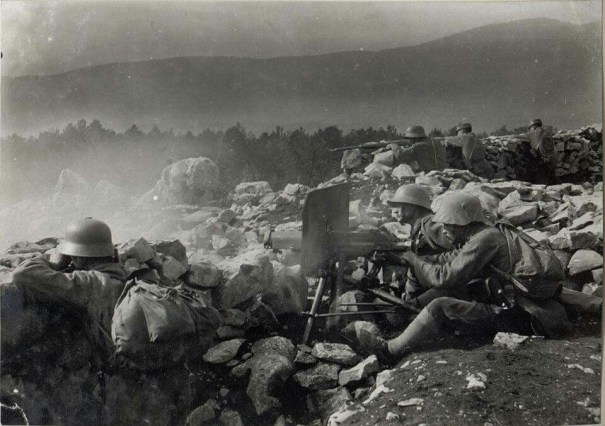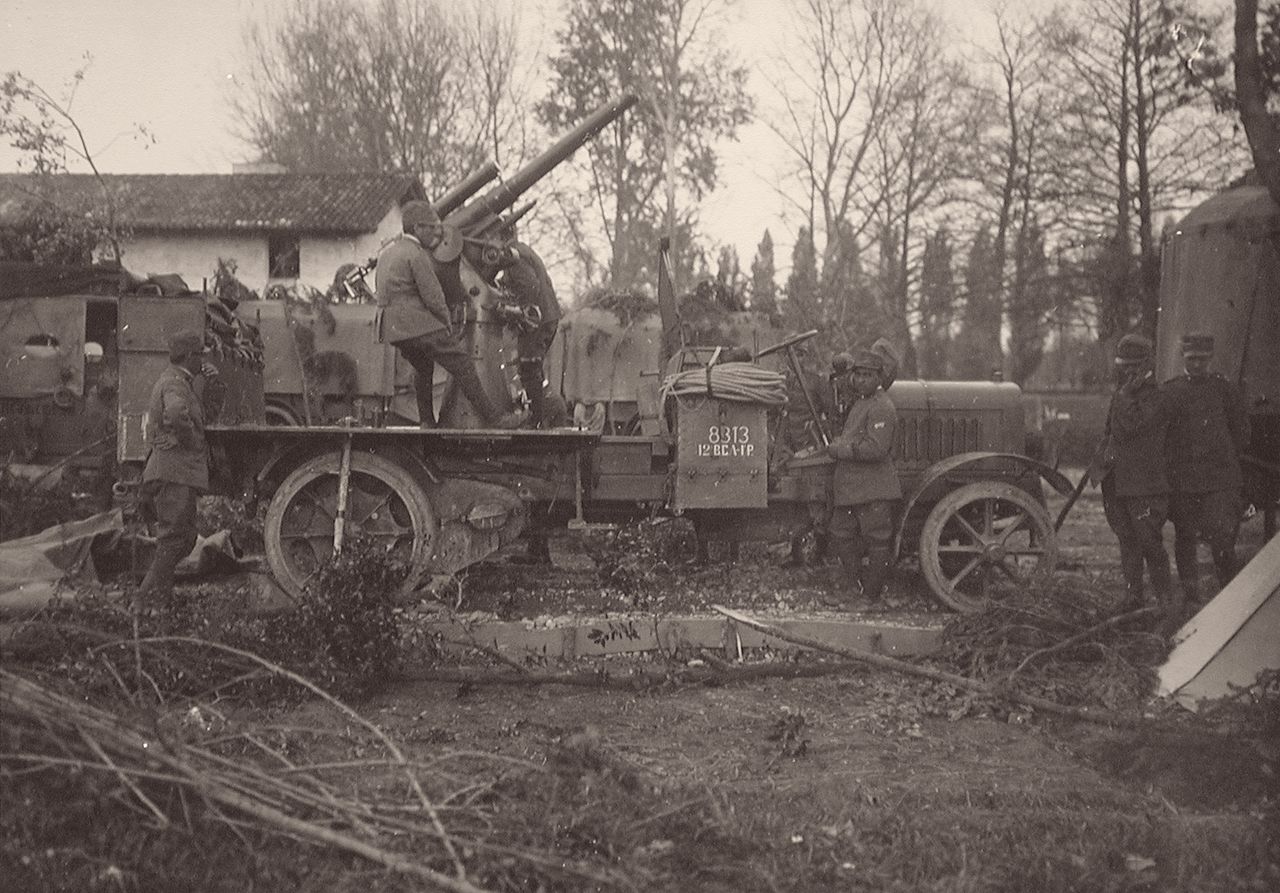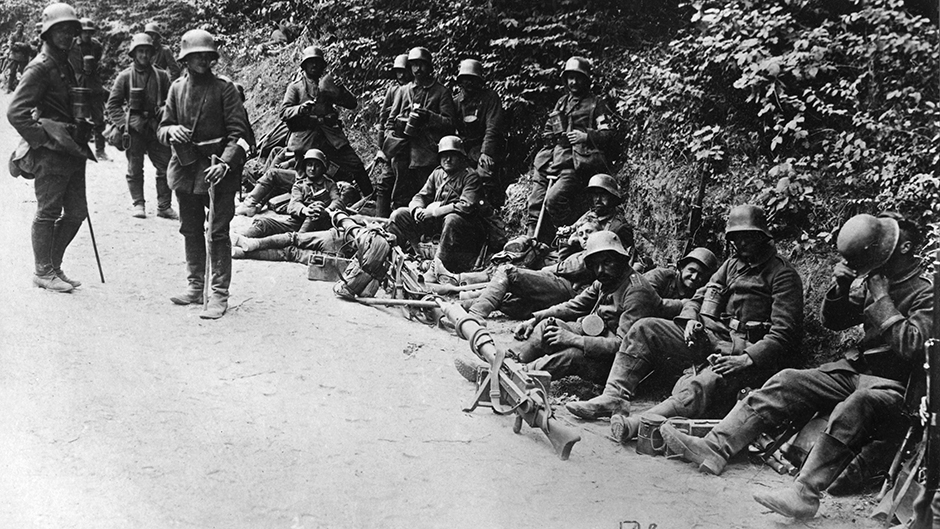X. - XII. Isonzo battle and Caporetto breakthrough
| Site: | MOOC Charles University |
| Course: | Italian front 1915-1917 along the Isonzo river - 2021 |
| Book: | X. - XII. Isonzo battle and Caporetto breakthrough |
| Printed by: | Guest user |
| Date: | Thursday, 4 December 2025, 11:14 AM |
1. X. Isonzo battle
12 May 1917 - 5 June 1917
During the winter Italian army strengthened massively and waited until the weather enabled the beginning of the large offensive. They rallied 36 divisons, far more than their opponent. Despite the great superiority of the Italian army, there was no shift on the southern front. Above all, it turned out that the Italians were unable to carry out a key attack. On the contrary it confirmed the success of the Austro-Hungarian defense. In three weeks Cadorna ocuppied only one village near the Karst Plateau.
Source:
FUČÍK, J.: Soča (Isonzo) 1917, Prague-Litomyšl 1999.
FUČÍK, J. / PAVLÍK, M.: Sočská fronta 1915-1917, Prague 2008.
ŠEDIVÝ, I.: Češi, české země a Velká válka 1914-1918, Prague 2001.
X. Isonzo battle - Austro-Hungarian troops return fire

Source:
https://ww1.blogberth.com/2017/05/13/greatwar-1914may-12-1917-tenth-battle-of-the-isonzo-begins/
1.1. Video
X. Isonzo battle
Time:
5:02 - 7:26
2. XI. Isonzo battle
18 August 1917 - 12 September 1917
After previous not very big sucesses Luigi Cadorna decided to change the strategy. The Italian troops struck in two directions - in the north on the high Banjšice Plateau and in the south towards Terst. The invaders managed to conquer the Banjšice Plateau, but in the southern direction they gained a little profit. The XI. Isonzo battle brought some tactical advantage to the Italian Army, because now there was a danger of fragmentation of the southern front. It was clear that Boroevic is not satisfied with this situation and he is going to try to reverse the result of the last battle.
Source:
FUČÍK, J.: Soča (Isonzo) 1917, Prague-Litomyšl 1999.
FUČÍK, J. / PAVLÍK, M.: Sočská fronta 1915-1917, Prague 2008.
ŠEDIVÝ, I.: Češi, české země a Velká válka 1914-1918, Prague 2001.
XI. Isonzo battle - Italian 75mm anti-aircraft gun

Source:
2.1. Video
XI. Isonzo battle
Time:
0:45 - 4:09
3. XII. Isonzo battle - Caporetto
24 October 1917 - 18 November 1917
The scale of the mass army war has so far been exceeded by the great loss of life and material forces. The Austro-Hungarian Command was forced to look for a strategic solution to the crisis situation, as it turned out in these positional battles that it would no longer be possible to withstand the constant pressure of the more powerful Italian adversary.
Already from the tenth sculpture battle, the idea of counter-offensive has gradually crystallized from the northern section of the Saxon front. This operation eventually turned into the second largest and one of the most successful World War I operations. The Austro-Hungarian Command assumed that the best defense would be the counter-attack on the enemy, and therefore a strategic initiative must be taken. The prospect of a successful offensive was supposed to be at Isonzo, because the transport of forces and resources to the Tyrolean front would be very difficult. Finally, it was also necessary to create a new, unexploited assault force, to achieve success, as the Saxon army would not be enough to make a strike. That is why AOK turned to help its German allies. The German command of this plea, despite the heavy fighting at Verdun, has complied. He temporarily assigned six infantry divisions and several artillery units, which were complemented by five Austro-Hungarian divisions, and the 14th Army was formed. It was commanded by German General Otto von Below. This group should try to break into the Italian interior. The Austro-Hungarian forces from the central and southern part of the Saxon Front, now grouped into the 1st and 2nd Saxon Army, which Boroević continued to command, would join him.
Source:
FUČÍK, J.: Soča (Isonzo) 1917, Prague-Litomyšl 1999.
FUČÍK, J. / PAVLÍK, M.: Sočská fronta 1915-1917, Prague 2008.
ŠEDIVÝ, I.: Češi, české země a Velká válka 1914-1918, Prague 2001.
XII. Isonzo battle - German troops with Cannons

4. Start of offensive
The offensive was carefully prepared and secured on the material side. Below tried to leave nothing to chance and received important news about Italian positions.
The mountain terrain between Bovec (Plezzo, Flitsch) and Tolmin, which was defended by the Italian 2nd Army, was chosen to carry out these intentions. Caporetto, a few kilometers behind the Soca's queue, was the natural link of the queue on both wings - at Bovec and Tolmin. The German 14th Army Otty von Below, reinforced by the Austro-Hungarian divisions, has gradually moved to the embassies between the two towns. The four groups (from the north) Krauss, Stein, Berrer, Scotti formed this 14th army. On the right side was the Austro-Hungarian 10th Army, and on the left (in the middle and south sections of the Saxon Front), there were two Sachs army, to which the only single army had been divided.
On October 24, around 2 am, an allied offensive was launched by deploying gas in the Bovce basin alongside Soča in the misty weather, which was to the benefit of a fast-paced attacker. Six hours later, heavy artillery was added, which gradually increased. There was still a fog in the valleys, the snow blizzard drifting over the ridges. Upon completion of the artillery preparation, the Krauss group set off at Bovce on the right wing of the 14th Army. Already at around ten o'clock, "The Striking Front of the 22nd Rifle Division, the 26th Rifle Regiment, in cooperation with the Battalion of the 3rd Rifle Regiment, broke the first Italian line at the eastern edge of Bovce at about 10 am." In the evening it was without a special fight in the hands of the second and third Italian divisions, and the 43rd Shooter Brigade went to the village of Saga. Although the other parts of the church (for example, at Rombon) did not succeed, the path to the west was open.
Source:
FUČÍK, J.: Soča (Isonzo) 1917, Prague-Litomyšl 1999.
FUČÍK, J. / PAVLÍK, M.: Sočská fronta 1915-1917, Prague 2008.
ŠEDIVÝ, I.: Češi, české země a Velká válka 1914-1918, Prague 2001.
Battle - German assault troops with MG 08/15

Source:
5. The End of Caporetto
After the start of the offensive Italian troops collapsed. Austro-Hungarian military units conquered one line of defense after another and got to Piave. In the night between 26 and 27 October 1917 General Cadorna ordered the withdrawal of the Second and Third Army from the Tagliamento River. He also commanded the immediate departure of the Carnia and Cadore areas. This order meant a quick withdrawal of 1, 5 million men. The outcome of the battle was decided.
After the defeat of Caporetto the Allies sent troops to support the Italian army that was laboriously rearranging itself. They were reinforced by six French and five British divisions. The Struggle on this territory continued until the end of the Great War.
Source:
LABANCA, N.: Caporetto. Storia di una disfatta. Florence 2000.
ISNENGHI, M. / Rochat, G.: La grande guerra, 1914-1918. Florence 2000.
Italian prisoners of war after the Battle

Source:
5.1. Video
Caporetto
Time:
4:15 - 10:19